Signal Generator output on an analog oscilloscope
Hi,
I'm interested in exploring the effects of various components on sweep signals. I'm using SignalScope 3.0.4 Signal Generator as a sweep generator and an analog oscilloscope to look at it. The sweep takes about 1/10 to cover a 0-20kHz range. According to the doc, the log sweep (which I am using) exhibits a pink magnitude response--i.e., a 3db/oct. drop in magnitude with increasing frequency.
On the oscilloscope, I see the attached trace. This is a single sweep photographed with a second-long exposure. The trigger is set so that the scope sweep starts with the signal generator frequency sweep, so the low frequency signal is on the left and the wavelength gets progressively shorter as you move to the right.
I'm puzzled, though, why the overall waveform rises as frequency rises. I can't understand where that rising DC offset would come from. Also, does the tapering look right to you--3 db/oct. seems to take a long time to kick in and then it does with a vengeance at the end...is that to be expected with a logarithmic sweep?
I see a similar tapering and rising envelope phenomenon with the linear sweep--but it's very hard to get a stable trace that shows the whole thing for a photo, so I won't include it here.
Finally, the doc says that the high and low frequency limits for the sweep depend on the settings of the FFT portion of the suite, but no matter where I set the high frequency limit in that app, the sweep seems to run the same range. Am I missing something?
Thanks for any help you can offer!
- Ken
I'm interested in exploring the effects of various components on sweep signals. I'm using SignalScope 3.0.4 Signal Generator as a sweep generator and an analog oscilloscope to look at it. The sweep takes about 1/10 to cover a 0-20kHz range. According to the doc, the log sweep (which I am using) exhibits a pink magnitude response--i.e., a 3db/oct. drop in magnitude with increasing frequency.
On the oscilloscope, I see the attached trace. This is a single sweep photographed with a second-long exposure. The trigger is set so that the scope sweep starts with the signal generator frequency sweep, so the low frequency signal is on the left and the wavelength gets progressively shorter as you move to the right.
I'm puzzled, though, why the overall waveform rises as frequency rises. I can't understand where that rising DC offset would come from. Also, does the tapering look right to you--3 db/oct. seems to take a long time to kick in and then it does with a vengeance at the end...is that to be expected with a logarithmic sweep?
I see a similar tapering and rising envelope phenomenon with the linear sweep--but it's very hard to get a stable trace that shows the whole thing for a photo, so I won't include it here.
Finally, the doc says that the high and low frequency limits for the sweep depend on the settings of the FFT portion of the suite, but no matter where I set the high frequency limit in that app, the sweep seems to run the same range. Am I missing something?
Thanks for any help you can offer!
- Ken
0

Comments
First, it should be noted that this post pertains to the signal generator tool in SignalScope (available via in-app purchase), which is not the same as SignalSuite. This is why this post was moved from the SignalSuite forum to the SignalScope forum.
The rise is due to the low-frequency "tail" wrapping around into the high frequency part of the sweep (it's not a DC offset). This happens because the sweep is synthesized in the frequency domain and converted to a time-domain signal via inverse FFT.
"Logarithmic sweep" means that the frequency increases logarithmically, so the frequency increases more rapidly toward the end of the sweep. A -3 dB per octave slope in the frequency domain basically means that the sweep spends more time at lower frequencies and less time at higher frequencies.
The lower frequency bound of the sweep is always 0 Hz (or something close to that, in the case of a log sweep). The upper frequency bound is determined by the sample rate of the audio input signal. The upper frequency limit is half the sample rate, which is typically 48 kHz, although some devices only sample at 44.1 kHz. You cannot manually change the sample rate within SignalScope.
Perhaps, you are referring to the sweep duration, which is tied to the length of the FFT in the FFT analyzer. Increasing the frequency resolution of the FFT analyzer (selecting a smaller value, in Hz) will also increase the duration of the sweep.
Ben